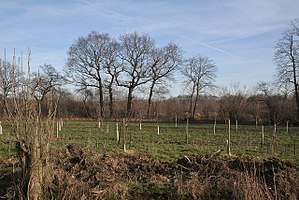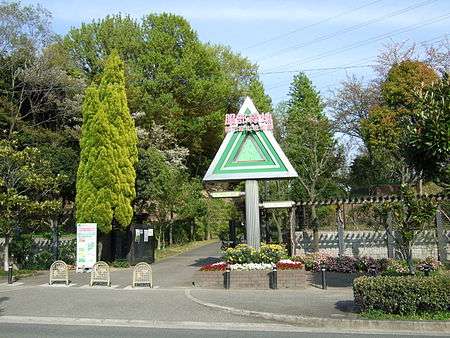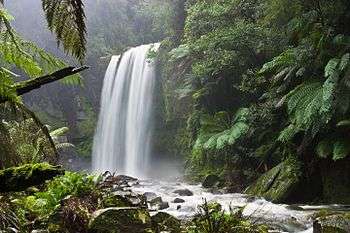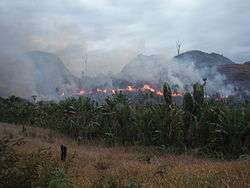Afforestation

Afforestation is the establishment of a forest or stand of trees (forestation) in an area where there was no previous tree cover.[1]
Many government and non-governmental organizations directly engage in programs of afforestation to create forests, increase carbon capture and carbon sequestration, and help to anthropogenically improve biodiversity. In the UK, afforestation may mean converting the legal status of some land to royal forest.
Processes
Gap dynamics is the pattern of plant growth that occurs following the creation of a forest gap, a local area of natural disturbance that results in an opening in the canopy of a forest. Gap dynamics are a typical characteristic of temperate and tropical forests, and have a wide variety of causes and effects on forest life.
Sometimes special tools, such as a tree planting bar, are used to make planting of trees easier and faster.
In areas of degraded soil
In some places, forests need help to reestablish themselves because of environmental factors. For a example, in arid zones, once forest cover is destroyed, the land may become dry and inhospitable for the growth of new trees . Other factors include overgrazing by livestock, especially animals such as goats, cows, and over-harvesting of forest resources. Together these may lead to desertification and the loss of topsoil; without soil, forests cannot grow until the long process of soil creation has been completed - if erosion allows this. In some tropical areas, forest cover removal may result in a duricrust or duripan that effectively seal off the soil to water penetration and root growth. In many areas, reforestation is impossible because people are using the land. In other areas, mechanical breaking up of duripans or duricrusts is necessary, careful and continued watering may be essential, and special protection, such as fencing, may be needed.
Forests to attract rain
Several new studies suggest that forests attract rain and this may explain why drought is occurring more frequently in parts of the world such as western Africa. A new study by Carol Rasmussen, NASA's Jet Propulsion Laboratory gives the first observational evidence that the southern Amazon rain forest triggers its own rainy season using water vapor from plant leaves. The finding helps explain why deforestation in this region is linked with reduced rainfall [2] A study by Douglas Sheil and Daniel Murdiyarso hypothesis suggests that forest cover plays a much greater role in determining rainfall than previously recognized. It explains how forested regions generate large-scale flows in atmospheric water vapor[3] Makarieva and Gorshkov have developed a hypothesis to explain how forests attract moist air and increase rainfall in area covered by trees [4]
Countries and regions
Brazil
There is extensive and ongoing Amazon deforestation.[5]). There is also ongoing afforestation effort in Brazil. In an afforestation hotspot outlined in Para, Brazil, 1 billion trees are intended to be planted to restore deforested lands by 2013.[6]
China
China has deforested most of its historically wooded areas. China reached the point where timber yields declined far below historic levels, due to over-harvesting of trees beyond sustainable yield.[8] Although it has set official goals for reforestation, these goals are set over an 80-year time horizon and have not been significantly met by 2008. China is trying to correct these problems by projects like the Green Wall of China, which aims to replant a great deal of forests and halt the expansion of the Gobi desert. The Green Wall of China Project has historical precedences dating back to before the Common Era. However, in pre-modern periods, government sponsored afforestation projects along the historical frontier regions were mostly for military fortification.[9]
A law promulgated in 1981 requires that every school student over the age of 11 plants at least one tree per year. As a result, China has the highest afforestation rate of any country or region in the world, with 47,000 square kilometers of afforestation in 2008.[10] However, the forest area per capita is still far lower than the international average.[11] There has also been considerable criticism regarding the effectiveness of planting so many trees especially in regions where they never grew prior. Studies reveal that the water table of those areas is becoming deeper indicating significant water loss.
India

India has witnessed a minor increase in the percentage of the land area under forest cover from 1950 to 2006. In 1950 around 40.48 million hectares was covered by forest. In 1980 it increased to 67.47 million hectares and in 2006 it was found to be 69 million hectares. 23% of India is covered by forest.[12] The forests of India are grouped into 5 major categories and 16 types based on biophysical criteria. 38% of the forest is categorized as subtropical dry deciduous and 30% as tropical moist deciduous and other smaller groups. Only local species are planted in an area. Trees bearing fruits are preferred wherever possible due to their function as a food source.
Hong Kong
Since the founding of the crown colony in the 19th century, afforestation has taken place to prevent soil erosion in the catchment areas of the reservoirs that were built. During the Japanese occupation in the Second World War, the countryside was deforested as the remaining population required fuel to survive. Most of the trees were cut down and extensive reafforestation was carried out after the war. Trees that were planted are mostly non-native species, such as: Pinus massoniana, Acacia confusa (Formosan acacia), Lophostemon confertus and the Paper Bark Tree.
Burkina Faso
Desertification is increasing along the Sahel, the strip of land between Africa's fertile tropics and the Sahara Desert. After a crippling famine in the 1970s caused by overgrazing and deforestation, a local community approach has been pioneered by Yacouba Sawadogo, a peasant farmer.[13] By replanting trees and crops together in holes filled with compost, whole villages have been able to move back to areas considered uninhabitable.
Iran
Iran is considered a low forest cover region of the world with present cover approximating seven percent of the land area. This is a value reduced by an estimated six million hectares of virgin forest, which includes oak, almond and pistachio.[14] Due to soil substrates, it is difficult to achieve afforestation on a large scale compared to other temperate areas endowed with more fertile and less rocky and arid soil conditions.[14] Consequently, most of the afforestation is conducted with non-native species,[14] leading to habitat destruction for native flora and fauna, and resulting in an accelerated loss of biodiversity.[5]
Since 1996, with the preparation and testing of areas suitable for afforestation in the highlands of northern Tehran, the plan of flooding began with the name of the Southern Alborz Range forestry plan, which will cover approximately 2700 hectares of afforestation by 2017.By 2020, more than 2000 hectares will be added to the plan.(Amiri)
Japan

Israel

Tree-planting is an ancient Jewish tradition, mentioned in the Talmud as being more important than greeting the Messiah.[15] With over 240 million planted trees, Israel is one of only two countries that entered the 21st century with a net gain in the number of trees, due to massive afforestation efforts.[16] Israeli forests are the product of a major afforestation campaign by the Jewish National Fund (JNF).[17]
Critics argue that many JNF lands inside the West Bank were illegally confiscated from Palestinian refugees, and that the JNF furthermore should not be involved with lands in the West Bank.[18] Shaul Ephraim Cohen has claimed that trees have been planted to restrict Bedouin herding.[19] Susan Nathan wrote that forests were planted on the site of abandoned Arab villages after the 1948 war.[20]
Since 2009, the JNF has provided the Palestinian Authority with 3,000 tree seedlings for a forested area being developed on the edge of the new city of Rawabi, north of Ramallah.[21]
North Africa
In North Africa, the Sahara Forest Project coupled with the Seawater greenhouse has been proposed. Some projects have also been launched in countries as Senegal to revert desertification. As of 2010, African leaders are discussing the combining of national resources to increase effectiveness.[22] In addition, other projects as the Keita Project in Niger have been launched in the past, and have been able to locally revert damage done by desertification. See Development aid#Effectiveness
Europe
Europe has deforested the majority of its historical forests. The European Union (EU) has paid farmers for afforestation since 1990, offering grants to turn farmland back into forest and payments for the management of forest. Between 1993 and 1997, EU afforestation policies made possible the re-forestation of over 5,000 square kilometres of land. A second program, running between 2000 and 2006, afforested more than 1000 square kilometres of land (precise statistics not yet available). A third such program began in 2007. Europe's forests are growing by 0.8 million ha a year thanks to these programmes.[23]
In Poland, the National Program of Afforestation was introduced by the government after World War II, when area of forests shrank to 20% of country's territory. Consequently, forested areas of Poland grew year by year, and on December 31, 2006, forests covered 29% of the country (see: Polish forests). It is planned that by 2050, forests will cover 33% of Poland.
According to Food and Agriculture Organization statistics, Spain had the third fastest afforestation rate in Europe in the 1990-2005 period, after Iceland and Ireland.[24][25] In those years, a total of 44,360 square kilometers were afforested, and the total forest cover rose from 13,5 to 17,9 million hectares. In 1990, forests covered 26.6% of the Spanish territory. As of 2007, that figure had risen to 36.6%. Spain today has the fifth largest forest area in the European Union.[26]
In January 2013 the UK government set a target of 12% woodland cover in England by 2060, up from the then 10%.[27] Government-backed initiatives such as the Woodland Carbon Code are intended to support this objective by encouraging corporations and landowners to create new woodland to offset their carbon emissions.
Alpine and Subalpine regions have undergone a lot of deforestation and then forestation in the last 300 years. Out of this has emerged much practical experience. One example is the clustered group,[28] which is a method to bring in stable age mixed tree communities.
Australia
In Adelaide, South Australia (a city of 1.3 million as of June 2016),[29] Premier Mike Rann (2002 to 2011) launched an urban forest initiative in 2003 to plant 3 million native trees and shrubs by 2014 on 300 project sites across the metro area. The projects range from large habitat restoration projects to local biodiversity projects. Thousands of Adelaide citizens have participated in community planting days. Sites include parks, reserves, transport corridors, schools, water courses and coastline. Only trees native to the local area are planted to ensure genetic integrity. Premier Rann said the project aimed to beautify and cool the city and make it more liveable; improve air and water quality and reduce Adelaide's greenhouse gas emissions by 600,000 tonnes of C02 a year. He said it was also about creating and conserving habitat for wildlife and preventing species loss.[30]
United States
The United States is roughly one-third covered in forest and woodland. Nevertheless, areas in the US were subject to significant tree planting. In the 1800s people moving westward encountered the Great Plains – land with fertile soil, a growing population and a demand for timber but with few trees to supply it. So tree planting was encouraged along homesteads. Arbor Day was founded in 1872 by Julius Sterling Morton in Nebraska City, Nebraska. By the 1930s the Dust Bowl environmental disaster signified a reason for significant new tree cover. Public works programs under the New Deal saw the planting of 18,000 miles of windbreaks stretching from North Dakota to Texas to fight soil erosion (see Great Plains Shelterbelt).
At their summit in Copenhagen in 2009, organised by the UK based The Climate Group, leaders of subnational governments – states, regions and provinces – unanimously supported a recommendation by Premier Rann to plant one billion trees across their varied jurisdictions. The initiative was strongly supported by leaders present including Quebec Premier Jean Charest, California Governor Arnold Schwarzenegger and Scottish First Minister Alex Salmond. At a subsequent meeting in Rio de Janeiro in June 2012, The Climate Group announced that it had already received commitments by member governments to plant more than 500 million trees.[31]
Criticism
The use of afforestation as strategy of conservation of forest biomes is seen as a menace to the conservation of natural grassland and savanna biomes, as the ideal would be the reforestation of areas where forest occurs naturally.[32]
See also
- Agroforestry
- Buffer strip
- CarbonFix Standard
- Deforestation
- Deforestation and climate change
- Desertification
- Forest dynamics
- Forestry
- Great Plains Shelterbelt
- Groasis Waterboxx
- International Year of Forests
- Japanese afforestation
- Reforestation
- Sand fence
- Seawater greenhouse
- Tubestock
- Windbreak
- The Man Who Planted Trees
References
Notes
- ↑ "SAFnet Dictionary | Definition For [afforestation]". Dictionaryofforestry.org. 2008-10-23. Archived from the original on 2012-03-14. Retrieved 2012-02-17.
- ↑ Carol Rasmussen (2017), New study shows the Amazon makes its own rainy season, NASA's Jet Propulsion Laboratory, https://climate.nasa.gov/news/2608/new-study-shows-the-amazon-makes-its-own-rainy-season/
- ↑ Douglas Sheil Daniel Murdiyarso BioScience, Volume 59, Issue 4, 1 April 2009, Pages 341–347,https://doi.org/10.1525/bio.2009.59.4.12
- ↑ Makarieva AM, Gorshkov VG, 2007, Biotic pump of atmospheric moisture as driver of the hydrological cycle on land, Hydrology and Earth System Sciences, 11: 1013–1033
- 1 2 E. O. Wilson, 2002
- ↑ "Afforestation in Para, Brazil". NASA Land-Cover/Land-Use Change Program. Retrieved 4 April 2018.
- ↑ 省河道堤防建设管理局2016年工作要点 (The work goals of the provincial waterway flood protection levee administration for 2016), 2016-02-17
- ↑ G.A.McBeath, 2006
- ↑ Chen, Yuan Julian (2018). "FRONTIER, FORTIFICATION, AND FORESTATION: DEFENSIVE WOODLAND ON THE SONG–LIAO BORDER IN THE LONG ELEVENTH CENTURY". Journal of Chinese History. 2 (2): 313–334. doi:10.1017/jch.2018.7. ISSN 2059-1632.
- ↑ "China to plant more trees in 2009_English_Xinhua". News.xinhuanet.com. 2009-01-09. Retrieved 2012-02-17.
- ↑ "51.54 billion trees planted by ordinary Chinese in 27 years - People's Daily Online". English.people.com.cn. 2008-03-11. Retrieved 2012-02-17.
- ↑ "India: Environmental Profile". rainforests.mongabay.com. Retrieved 2015-05-04.
- ↑ Wildash, Paula. "1080 Films - The Man Who Stopped The Desert". www.1080films.co.uk. Retrieved 2015-05-04.
- 1 2 3 J.A.Stanturf, 2004
- ↑ "President of German States Council of Education Ministers Plants Tree at Kennedy Memorial". JPost.com: Green Israel: People And The Environment. Jerusalem Post. The Jerusalem Post. July 29, 2009. Retrieved December 13, 2013.
- ↑ "Israel Forestry & Ecology". Jewish National Fund, East 69th Street, NY 10021 USA. Retrieved 29 October 2011.
- ↑ "JNF Tree Planting Center". Jewish National Fund, East 69th Street, NY 10021, USA. Retrieved 29 October 2011.
- ↑ Dan Leon."The Jewish National Fund: How the Land Was ‘Redeemed’: The JNF's historical concept of exclusively Jewish land is wholly anachronistic"; Palestine-Israel Journal, Vol 12 No. 4 & Vol 13 No. 1, 05/06
- ↑ Shaul Ephraim Cohen. "The Politics of Planting"; University of Chicago 1993 p.121
- ↑ Nathan, Susan (2005). The Other Side of Israel: My Journey Across the Jewish/Arab Divide. New York: Nan A. Talese. pp. 130–131. ISBN 978-0-385-51456-9.
- ↑ Gross, Tom (2009-12-02). "Building Peace Without Obama's Interference". Online.wsj.com. Retrieved 2013-12-21.
- ↑ "Combining of green walls". Afriqueavenir.org. Archived from the original on 2010-07-18. Retrieved 2012-08-26.
- ↑ "European Wood_Forest growth". www.europeanwood.org.cn. Retrieved 2015-05-04.
- ↑ "FAO Data". Blatantworld.com. Archived from the original on 2010-07-09. Retrieved 2012-08-26.
- ↑ "Mongabay.com: Deforestation tables and charts for Spain". Rainforests.mongabay.com. Retrieved 2012-08-26.
- ↑ "United Nations Statistics Division - Environment Statistics". Unstats.un.org. Retrieved 2012-02-17.
- ↑ "Government Forestry and Woodlands" (PDF). Defra. Retrieved 13 June 2013.
- ↑ http://www.waldwissen.net/waldwirtschaft/waldbau/bergwald/wsl_rottenaufforstung/index_DE
- ↑ "Ten years of growth: Australia's population hot spots". Australian Bureau. Archived from the original on 2017-09-30. Retrieved 29 July 2017.
- ↑ http://www.milliontrees.com.au Archived 2014-09-24 at the Wayback Machine.
- ↑ http://www.theclimategroup.org
- ↑ Veldman, J.W., Overbeck, G.E., Negreiros, D., Mahy, G., Le Stradic, S., Durigan, G., Buisson, E., Putz, F.E. & Bond, W.J. (2015). Tyranny of trees in grass land Science, 347, 484–485. link.
Bibliography
- Buendia C, Batalla RJ, Sabater S, Palau A, Marce R. (2016). Runoff Trends Driven by Climate and Afforestation in a Pyrenean Basin. Land Degradation & Development. DOI: 10.1002/ldr.2384
- Buendia C, Bussi G, Tuset J, Vericat D, Sabater S, Palau A, Batalla RJ. (2016). Effects of afforestation on runoff and sediment load in an upland Mediterranean catchment. Science of the Total Environment. DOI: 10.1016/jscitotenv.2015.07.005
- Cattaneo, Andrea (2002) Balancing Agricultural Development and Deforestation in the Brazilian Amazon, Int Food Policy Res Inst IFPRI, 146 pages ISBN 0-89629-130-8
- Heil, Gerrit W., Bart Muys and Karin Hansen (2007) Environmental Effects of Afforestation in North-Western Europe, Springer, 320 pages ISBN 1-4020-4567-0
- Halldorsson G., Oddsdottir, ES and Sigurdsson BD (2008) AFFORNORD Effects of Afforestation on Ecosystems, Landscape and Rural Development, TemaNord 2008:562, 120 pages ISBN 978-92-893-1718-4
- Halldorsson G., Oddsdottir, ES and Eggertsson O (2007) Effects of Afforestation on Ecosystems, Landscape and Rural Development. Proceedings of the AFFORNORD conference, Reykholt, Iceland, June 18–22, 2005, TemaNord 2007:508, 343pages ISBN 978-92-893-1443-5
- McBeath, Gerald A., and Tse-Kang Leng (2006) Governance of Biodiversity Conservation in China and Taiwan, Edward Elgar Publishing, 242 pages ISBN 1-84376-810-0
- Stanturf, John A. and Palle Madsen (2004) Restoration of Boreal and Temperate Forests, CRC Press, 569 pages ISBN 1-56670-635-1
- Wilson, E. O. (2002) The Future of Life, Vintage ISBN 0-679-76811-4

